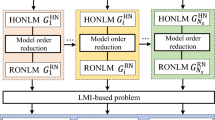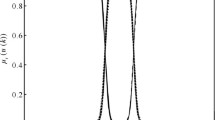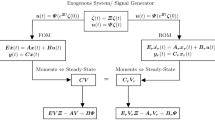Abstract
This paper deals with the control of nonlinear systems using multimodel approach. The main idea of this work consists on the association of the gap metric and the stability margin tools to reduce the number of models constituting the multimodel bank. In fact, the self-organisation map (SOM) algorithm is used, firstly, to develop a preliminary multimodel bank. Then, the gap metric and the stability margin are computed to determine the redundancy of the initial multimodel bank. So, the multimodel controller is elaborated based on the reduced model bank. Simulations confirm the method for selecting the appropriate number of local models which should be used in the controller design.
Similar content being viewed by others
References
T. Wen, H. J. Marquezb, C. Tongwen, and L. Jizhen, “Multimodel analysis and controller design for nonlinear processes,” Computers and Chemical Engineering, vol. 28, no. 12, pp. 2667–2675, 2004.
J. Du, C. Song, and P. Li, “Application of gap metric to model bank determination in multilinear model approach,” Journal of Process Control, vol. 19, no. 9, pp. 231–240, 2009.
K. Hariprasad, B. Sharad, and D. G. Ravindra, “A gap metric based multiple model approach for nonlinear switched systems,” Journal of Process Control, vol. 22, no. 9, pp. 1743–1754, 2012.
A. N. Tamer, A. A. F. Hossam, and A. R. H. Adel, “Multiple-Model Adaptive Control for Interval Plants,” IJCAS, vol. 10, no. 1, pp. 11–19, 2012.
J. Du and T. A. Johansen, “A gap metric based weighting method for multimodel predictive control of MIMO nonlinear systems,” Journal of Process Control, vol. 53, no. 9, pp. 1346–357, 2014.
J. Du, C. Song, Y. Yaoc, and P. Li, “Multilinear model decomposition of MIMO nonlinear systems and its implication for multilinear model-based control,” Journal of Process Control, vol. 23, no. 3, pp. 271–281, 2013.
S. Hosseini, A. Fatehi, A. Sedigh, and T. A. Johansen, “Automatic model bank selection in multiple model identification of gas turbine dynamics,” Journal of Systems and Control Engineering, vol. 227, no. 5, pp. 482–494, 2013.
A. A. Jalali, H. Golmohammad, and H. Sadjadian, “Design and implementation of an optimal multiple model adaptive controller for line-of-sight stabilization,” Journal of Systems and Control Engineering, vol. 0, no. 0, pp. 1–13, 2013.
L. Giovanini, A. W. Ordys, and M. J. Grimble, “Adaptive Predictive Control using Multiple Models, Switching and Tuning,” International Journal of Control, Automation and Systems, vol. 4, no. 6, pp. 669–681, 2006.
C. Lee, “Adaptive Control of a Class of Nonlinear Systems Using Multiple Parameter Models,” International Journal of Control, Automation and Systems, vol. 4, no. 4, pp. 428–437, 2006.
J. H. Ryu, D. H. Han, K. K. Lee, and T. L. Song, “Prediction-based Interacting Multiple Model Estimation Algorithm for Target Tracking with Large Sampling Periods,” International Journal of Control, Automation and Systems, vol. 6, no. 1, pp. 428–437, 2008.
N. Elfelly, J. Y. Dieulot, M. Benrejeb, and P. Borne, “Multimodel control design using unsupervised classifiers,” Studies in Informatics and Control, vol. 21, no. 4, pp. 101–108, 2012.
A. Zribi, M. Chtourou, and M. Djemel, “Study of some clustering algorithms with a new cluster validity criterion,” Kuwait Journal of Science & Engineering, vol. 39, no. 1B, pp. 1–19, 2012.
O. Galán, J. A. Romagnoli, A. Palazoglu, and Y. Arkun, “Gap metric concept and implications for multilinear model-based controller design, Industrial,” Engineering Chemical Research, vol. 42, pp. 2189–2197, 2003.
S. M. Hosseini, A. Fatehi, T. A. Johansen, and A. K. Sedigh, “Multiple model bank selection based on nonlinearity measure and H-gap metric,” Journal of Process Control, vol. 22, no. 9, pp. 1732–1742, 2012.
J. Du and T. A. Johansen, “Integrated multimodel control of nonlinear systems based on gap metric and stability margin,” Ind. Eng. Chem. Res., vol. 53, no. 24, pp. 10206–10215, 2014.
T. Kohonen, Self-Organizing Maps, 2nd extended edition, Springer-Verlag, Berlin, Heidelberg, 1997.
O. Nelles, Nonlinear System Identification, Springer, Germany, 2001.
A. Shigeo, Neural Networks and Fuzzy Systems Theory and Applications, Kluwer Academic Publishers, 1997.
G. Zames and A. El-Sakkary, “Unstable systems and feedback: the gap metric,” Proc. Allerton Conference, pp. 380–385, 1980.
A. El-Sakkary, “The gap metric: robustness of stabilization of feedback systems,” IEEE Transactions on Automatic Control, vol. 30, no. 3, pp. 240–247, 1985.
T. T. Georgiou and M. C. Smith, “Optimal robustness in gap metric,” IEEE Transactions on Automatic Control, vol. 35, no. 6, pp. 673–686, 1990.
K. Zhou and J. Doyle, Essentials of Robust Control, Prentice Hall, Upper Saddle River, 1999.
M. A. Henson and D. E. Seborg, “Inputoutput linearization of general nonlinear processes,” AIChE Journal, vol. 36, no. 11, pp. 1753–1757, 1990.
F. J. Doyle, H. S. Kwatra, and J. S. Schwaber, “Dynamic gain scheduled process control,” Chemical Engineering Science, vol. 53, no. 15, pp. 2675–2690, 1998.
A. T. Azar and F. E. Serrano, “Robust IMCPID tuning for cascade control systems with gain and phase margin specifications,” Neuronal Computing and Applications, vol. 25, no. 5, pp. 983–995, 2014.
A. Uppal, W. H. Ray, and A. B. Poore, “On the dynamic behavior of continuous stirred tank reactors,” Chemical Engineering Science, vol. 29, no. 4, pp. 967–985, 1974.
R. C. Panda, “Synthesis of PID controller for unstable and integrating processes,” Chemical Engineering Science, vol. 64, no. 12, pp. 2807–2816, 2009.
D. Kim, D. Lee, and K. C. Veluvolu, “Accommodation of actuator fault using local diagnosis and IMC-PID,” International Journal of Control, Automation and Systems, vol. 12, no. 6, pp. 1139–1149, 2014.
Author information
Authors and Affiliations
Corresponding author
Additional information
Recommended by Associate Editor Soohee Han under the direction of Editor Euntai Kim.
Ali Zribi received his Engineering Diploma in Electrical Engineering in 2005, Master degree in Automatic Control in 2006, and Doctorate degree in 2011 from the National School of Engineers of Sfax, Tunisia (ENIS). He is currently an assistant professor at the higher Institute of Applied Science and Technology of Gabes. His areas of interest include identification, neural networks and multimodel control.
Mohamed Chtourou received his Engineering Diploma in Electrical Engineering from the Ecole Nationale dIngenieurs de Sfax-Tunisia in 1989, Diplôme dEtudes Aprofondies in Automatic Control from the Institut National des Sciences Appliquees de Toulouse-France in 1990, and Doctorat in Process Engineering from the Institut National Polytechnique de Toulouse-France in 1993 and the Habilitation Universitaire in Automatic Control from the Ecole Nationale dIngenieurs de Sfax-Tunisia in 2002. He is currently a Professor in the Department of Electrical Engineering of National School of Engineers of Sfax-University of Sfax-Tunisia. His current research interests include learning algorithms, artificial neural networks and their engineering applications, fuzzy systems, and intelligent control.
Mohamed Djemel received his BS and Diplome dEtudes Approfondies and Doctorat thesis in Electrical Engineering from the Ecole Superieure des Sciences Techniques de Tunis (ESSTT), in 1987 and 1989, and 1996, respectively, and Habilitation Universitaire from the Ecole Nationale dIngenieurs de Sfax (ENIS) in 2006. He jointed the Tunisian University since 1990, where he held different positions involved in research and education. Currently, he is a Professor of Automatic Control at the Electrical Department of the Ecole Nationale dIngenieurs de Sfax. His main research interests include the order reduction, the stability, the control and the advanced control of the complex systems.
Rights and permissions
About this article
Cite this article
Zribi, A., Chtourou, M. & Djemel, M. Multiple model reduction approach using gap metric and stability margin for control nonlinear systems. Int. J. Control Autom. Syst. 15, 267–273 (2017). https://doi.org/10.1007/s12555-015-0131-y
Received:
Revised:
Accepted:
Published:
Issue Date:
DOI: https://doi.org/10.1007/s12555-015-0131-y




